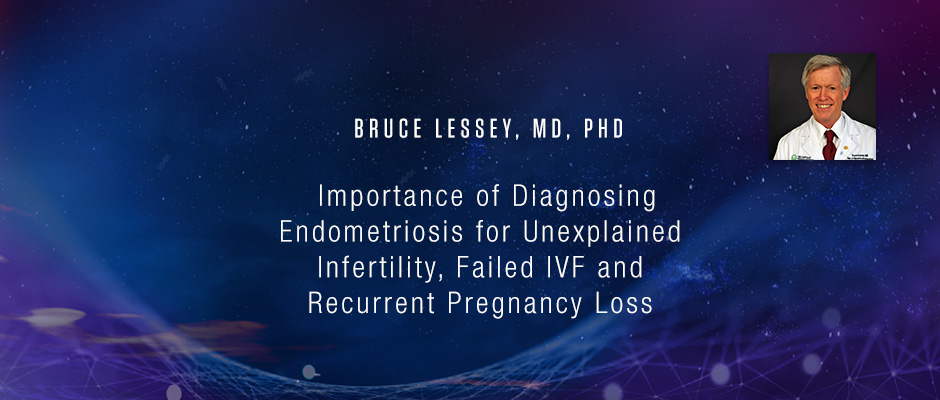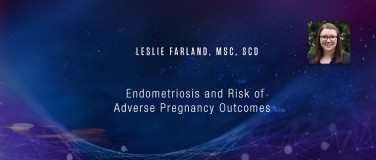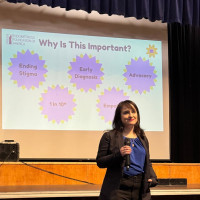Bruce Lessey, MD, PhD - Importance of Diagnosing Endometriosis for Unexplained Infertility, Failed IVF and Recurrent Pregnancy Loss
Endometriosis Foundation of America
Medical Conference 2019
Targeting Inflammation:
From Biomarkers to Precision Surgery
March 8-9, 2019 - Lenox Hill Hospital, NYC
https://www.endofound.org/medicalconference/2019
Thank you very much, thank you for inviting me to be here. I'd also like to thank the last speaker, who has really elaborated a widely held bias that probably isn't true, that endometriosis doesn't affect IVF. And I'll hopefully convince you by the end of my talk of the converse.
So I've been studying endometrium and endometriosis for the last 30 years or so, and much of that time has been involved in developing biomarkers that can be used to predict endometriosis or predict infertility, or direct therapy. And one of my conflicts, which I should list today, is that I'm talking about a test that we developed, and I am a scientific advisor to Cicero Diagnostics, so although I am not a paid consultant with them, I do get salary support from the NIH supported SPIR grant that we just received.
So, when you think about your most challenging patients, or if you're a patient, these are some of the criteria that we see. A history of failed transfers, recurrent pregnancy loss, either in natural cycles or IVF, often transferring good, normal PGT-A defined embryos as euploid and yet not having success. Having transfer timing adjusted but still having the transfer fail, and really this will impact on your ... not only your IVF success rates but it has kept the SART statistics really surprisingly low, despite the number of years that we've been doing IVF.
So what if the answer was right in front of us and we just stopped looking for it? And this whole idea of looking for endometriosis, especially in the setting of IVF, has really gone by the wayside. Here are the SART statistics showing how many women are diagnosed with endometriosis in an IVF program. Over time, this number's gone down. Alan [Detierney 00:02:47] has published a paper that said "Laparoscopy is dead. The only thing that remains is the obituary." And it really is true that since we ... when all we have is a hammer, everything looks like a nail. And if you're an IVF doc, and you're doing lots of IVF retrievals, that's what you do.
And as I mentioned, the bias is that endometriosis doesn't affect IVF, so why should we care? So, the unknown factors in the meantime have gone up, up to 50% of factors for IVF patients are in the unknown category. And only 3% are listed in recent SART statistics as having endometriosis. That's below the expected prevalence in the population, which is five to 10%. So this clearly, we're missing the mark on the diagnosis of endometriosis.
And this shows that over time, even though we think we're getting better, the overall outcome, live birth rate, or pregnancy rates, has really remained fairly stagnant. When you take normal embryos and put them back, you still get less than 50% success rates, and a study by Prapas from Greece, took sibling donor embryos, and put them back into women with and without endometriosis, and determined that when you control for the embryos, it's the endometrium of these women that appears to be defective, and determines whether or not they'll be successful.
So we have developed a model, we've done this in conjunction with work at UNC, and MSU, especially with Dr. Fazleabas, and Jae Wook Jeong, looking at markers of progesterone resistance. Oops, go back. Laser. So one of the ... and in keeping with the theme of our conference today ... inflammation is directly responsible for progesterone resistance phenomenon. With the elaboration of things like IL-1 and IL-17, you get IL-6 produced, which activates and stabilizes, or phosphorylates, STAT3. STAT3 is important for implantation, but it's not supposed to be on all the time, and there are several mechanisms to keep it turn off when it's not needed.
One of those is STAT5 that's induced by progesterone, and another is protein inhibitor of STAT3, that is there to turn STAT3 off whenever it's not being turned on. We recently showed that PIAS3 is down-regulated in endometriosis, and others have shown STAT5 is. STAT3, once activated, is a very dangerous protein, it's part of the inflammatory pathway, and it enlists hypoxia-induced factor, which is an angiogenic factor, stabilizes it. This protein is normally present only during menstruation, but in endometriosis, it's coming up in the mid-secretory phase, when embryos are trying to implant.
So what you get is a shift from progesterone action, which is there to turn off proliferation, and decrease cells from dividing, and allowing estrogen to become the predominant factor. Progesterone is there to down-regulate estrogen receptors, and in the situation where you have progesterone resistance, estrogen is actually ... estrogen receptors don't down-regulate and with aromatase being expressed there's a vicious cycle created where estrogen predominates.
Over here you see the same pathway, but we now bring in SERT1 and BCL6. BCL6 has turned out to be a useful protein in the assay for detecting endometriosis, though I'll get to it in a minute. But BCL6 is an oncogene, and SERT1 is a histone deacetylase. BCL6 knows where to go in the nucleus, knows what promoters to target, and SERT1 knows what to do. SERT1 is a protein that can turn off genes by taking care of the histones in those promoters. And it turns out that SERT1 is very good at turning off the progesterone receptor pathway, by inactivating a protein called GLI1. And so without progesterone, again, you get the estrogen dominance, and endometrial proliferation, which we think is part of the pathogenesis of endometriosis.
So you just saw this, these data, Kurt Barnhart's a good friend of mine, we were at Penn together. We actually had a good debate on this subject. But he published a paper showing that endometriosis really does not have much of an effect on IVF outcome, and in fact, it was only really pertinent in more severe cases. But if you think about it, I said 3% of the SART database has endometriosis. Have those patients ... Do those patients have endometriosis because we just took their word for it? No. They have endometriosis because we laparoscoped them.
So 100% of these patients have been treated for endometriosis, prior to their entry into the IVF program. Perhaps it's the patients with more severe disease that still have residual endometriosis, and might be more affected, whereas the more mild disease really is no longer the same.
So what is the role of laparoscopy in the treatment of endometriosis? Are these patients that have been diagnosed actually different from the patients in the IVF program that haven't been diagnosed? And I would argue, certainly they are. This paper by Littman, which is also Linda group, took 29 patients with unexplained IVF failure and laparoscoped them. Almost all of them had endometriosis, not surprisingly. After laparoscopy, most of them conceived, some naturally, and many with IVF, showing that endometriosis after it's treated, is not the same as it was before it was treated.
This is another way of looking at it. Daya examined patients with recurrent pregnancy loss. He actually looked at studies that had studied recurrent pregnancy loss, and it's relationship to endometriosis. If you look at studies that looked at women before diagnosis, they found a strong ... sorry. They found a strong correlation between the presence of endometriosis and recurrent loss. But if you look at patients after they've been diagnosed, that association pretty much disappeared. So you can't take any of the studies that talk endometriosis and IVF seriously, because none of those patients are untreated people who probably are more representative of what's going on in your IVF clinic.
Most women who have endometriosis in IVF programs don't know they have it. Many IVF failures appear to have undiagnosed endometriosis, and I'll present those data in a minute. Those with a diagnosis have already been treated, really invalidating the meta-analyses that we've been presented with. And the treatment of endometriosis in an unexplained IVF failure has been shown to result in pregnancies, with or without IVF, as was shown in the Littman paper.
So that brings us to BCL6. If you could detect the women with IVF ... or in IVF ... who have endometriosis, before surgery, then you would have a better population to ask the question, does endometriosis affect IVF outcome? When we looked at this, and this is what normal women look like, and this is a lymph node, what you see is that patients with endometriosis have a dramatic overexpression of this protein. When we looked at the patients that were normal for BCL6, the pregnancy rate approached 70%. But when you looked at the patients who were abnormal, the pregnancy rate was less than 20%. The take-home baby rate was significantly less than this.
And again, this is the relationship, showing BCL6 with SERT1. SERT1 is co-localized, here's double immunostaining for SERT1, BCL6, and then the merger, and when you immunoprecipitate one, you get the other. So again, these proteins are expressed together. One's activated by STAT3, the other is turned on by KRAS, and we've published those data within the last year.
This graph shows in the proliferative phase and the secretory phase, both KRAS and SERT1 are elevated, and they seem to correlate extremely way. And immunohistochemically, in endometriosis, these proteins are overexpressed. I was gonna show you a case study, but we don't have the internet to do that, but you can certainly go on the ReceptivaDx site, and see Cami talk about her own experience in IVF. Someone with no symptoms, a long distance runner who was the last person in the world I would have thought had endometriosis but tested positive, and we ended up laparoscoping her, and she now has a two-year-old daughter. It's a very compelling story.
So the company that's selling this test provided these data for me, and it shows that in no IVF failures in unexplained infertility, the positivity rate is still very high, 68%. When we laparoscoped these patients, we have a 93 and 96% sensitivity and specificity for finding endometriosis, and it covers all stages of endometriosis, interestingly. But as you go up in the number of IVF failures, the percentage of patients that test positive for this protein also increases.
So what do you do about this? Patients don't wanna be told they can't get pregnant, and so we got involved in a treatment protocol looking at surgery and Lupron in these patients, to try and come up with a better treatment plan. We just published these findings in JARG, Dr. Likes, one of my colleagues, was the first author. And it states that women with suspected endometriosis, based on BCL6 expression, had a much worse outcome, but what if ... and a higher miscarriage rate ... but if you pretreated them with either surgery or two months of Lupron, you could dramatically change the outcome.
And here is the graph showing that, and in the yellow I draw your attention to the very high miscarriage rate in natural IVF, up to 50% of patients who had conceived miscarried before they reached viability, whereas the miscarriage rate went significantly down, 50% and down to 16% after treatment of either surgery or Lupron. Graphically, you can see that the gray bars of the untreated people, this is the Lupron group, and this is the surgery group. Surgery and Lupron had similar success rates, so again, illustrating the point that you can't take endometriosis patients who have already been diagnosed, and expect that they will really give you any evidence for whether IVF will be successful or not. But if you could identify patients before they've been treated in their natural state, you can demonstrate that the success rate, live birth rate, clinical pregnancy rate, is quite low until treatment and that the miscarriage rate is quite high.
So to summarize, the ReceptivaDx is a test that measures BCL6. It's highly associated with endometriosis, has a high sensitivity and specificity, and studies have shown that women with elevated levels of this do poorly in the setting of IVF. Once identified, these women can be treated. We're now entering into a randomized, controlled trial using elagolix to look at patients in the IVF setting who have failed IVF, who have euploid embryos, and we'll be doing that over the next year or so. We also are biopsying everyone in our own clinic at Wake Forest, at the time of retrieval. Since we do PGT on almost everyone, we can delay whether we put the embryos back until after we test these patients, the thought being that if we could preemptively identify patients with poor prognosis, we could intervene and improve on our pregnancy rates in our own program, well above that 65 to 70% range that even the best clinics today are enjoying.
Finally, endometriosis is the most common diagnosis in unexplained infertility. I'm sure of that. Untreated endometriosis dramatically affects IVF outcome, probably because the endometrium is abnormal. Most women with failed IVF and euploid embryos will test positive for BCL6, and SERT1, as we're finding out. And treatment before embryo transfer should be able to reverse this trend.
Thank you for your attention.










